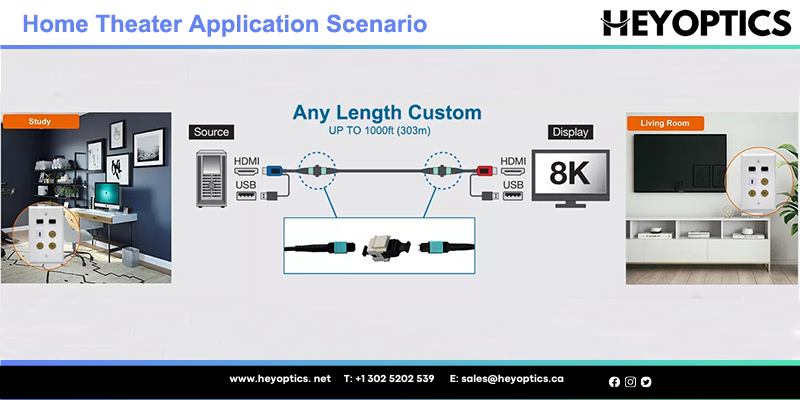Copper HDMI vs Fiber Optic HDMI Cable
In today's technology, HDMI cables are very popular in home theater systems, conferences and even video games that require an A/V connection. Fiber optic HDMI cables are a new, top-of-the-line option for connecting HDMI devices. Using fiber optics technology instead of traditional copper, fiber optic HDMI goes above and beyond the limitations of standard HDMI cables. However, some people may not know which type of cable to use in which situation. In this blog post, you'll learn why you need an optical HDMI cable instead of a regular (copper) HDMI cable.
Normal HDMI (Copper)
Normal or conventional HDMI cables are made of copper. Conventional HDMI is made using copper, with multiple smaller copper lines inside the main cable. Copper is a cheap material. The main drawback of conventional HDMI is the distance limit. Plain old HDMI caps out at a maximum limit of 65 feet, although depending on the equipment being used, the quality of the cables, and similar factors, issues can start to arise at distances as short as 50 feet.
Up until now, the only workaround to this would be using an extender balun. While baluns are certainly a fine solution, they are more cumbersome than a single HDMI cable and require a bit more work to set up. They can also have issues with maintaining 4k quality, especially over longer distances. Fiber optic HDMI not only lacks those issues but works even better than a standalone copper HDMI cable at peak performance.
Fiber Optic HDMI Cable
Fiber optic or optical cable is a new cutting-edge technology that goes above the normal HDMI cable and beyond limitations. The cables are usually slim, flexible, and light that can deliver top performance in very long distances. If you have heard fiber internet is much better speed than a normal internet, the Fiber optic HDMI works the same way as the internet. Fiber optic HDMI cable is one-directional, which means each end is marked individually for source and display. Therefore, you need to carefully use them.
Normal HDMI cables use electricity to transmit signals, while fiber optic cables use laser. The fiber optic works to transmit the HDMI signals, your device will convert them into pulses of light first. The pulses move at a very fast speed using fiber optics. When they arrive at their target, the light pulses revert to electrical signals. Because light (lasers) moves faster than electricity, the transmission of the signals via a fiber optic cable provides much better performance than a normal HDMI cable. The 8K era is coming, to install the ultimate quality home theater system, or fiber 4k hdmi cable for home theater, this fiber HDMI 2.1 cable is the best.

How to choose the best HDMI cable for you?
When choosing ordinary optical cable or optical cable, choose the shortest one. The recommended length of an optical HDMI cable is 10 meters. Meanwhile, for better performance on normal HDMI, it is better to use a cable less than 7 meters. Because with normal HDMI, their signal usually starts to degrade at a distance of 7 meters and starts to degrade at a distance of 15 meters. So if you need a longer cable, fiber optic or fiber optic cables are good options for the best video and audio quality.
To alleviate the problem of normal HDMI at specified distances, you can use an HDMI splitter, although it will increase the workload, it may also have problems maintaining 4/8K quality, especially at longer distances. Optical HDMI can provide a solution to such problems instead of using a separate normal HDMI cable along with the highest performance HDMI extender.
We are in the era of 4K/8k resolution. To send a lot of data from your streamer, Blu-ray player, game console or PC to your TV, you're going to need an optical HDMI cable. And 8k hdmi fiber cable is a very good choice. It provides the highest speed and bandwidth required for HD video and/or audio quality up to 303 meters (1000 feet) in length, supporting the long distances required for commercial video solutions.
Conclusion
If you're a video game enthusiast or have a home theater system, an optical HDMI cable is a great choice for audio and video transmission. As I said before, normal HDMI cables are cheap and made of copper, which is prone to interference. So, if you want a stable and reliable connection while gaming, as well as long distances (over 10 meters), you will need an optical HDMI cable.
Don't worry about choosing a high-quality optical HDMI cable. With our years of experience, you can count on helpful advice from Heyoptics' HDMI and audio/video experts.



